
The Merrimack Valley was spared the flooding that hit parts of Vermont, New Hampshire and western Massachusetts farms recently, but the heavy rain has had an impact here.
“Everybody’s lawn looks like the Amazon,” says Tim Breen of North Andover, who installs lawns and landscapes for a living.
It refers to the rainforest-like hues and growth in the Merrimack Valley that have emerged from deluges since early June.
This summer’s extremely wet conditions juxtaposed with the drought conditions of recent summers are consistent with global warming and are fraught with health and economic costs, say climate scientists like UMass Lowell professor Matt Barlow.
Barlow and a team of fellow climate scientists have investigated this weather effect in the Boston area, the propensity to pinball between drought and flood.
They presented their findings a year ago in a report, “Climate Change Impacts and Projections for the Greater Boston Area.”
Those recent impacts include 11.6 inches of rain in Andover, or 55 percent more than the 7.5 inches for all June and July averages from 1991 to 2020, according to National Weather Service meteorologist Glenn Field.
Methuen collected the rain award this year, from June 1 to July 20, with 14.1 inches or 89% more rain than the 30-year average for June and July.
Typically, by the end of July, the soil dries out and grass growth slows, and where the lawn isn’t fed or watered, it turns a sunburnt brown.
Landscaping crews go from mowing to cutting and pruning and installing walkways and patios.
The flood of late spring and early summer 2023 has resulted in many lost days of work, including a succession of Saturdays sacrificed to the rain deities. Landscapers usually bet on working on these summer Saturdays and doing a lot of things.
“It’s scary,” said Anthony Kivlehan of PMC Landscaping in Haverhill. “When it rains, we know we’re going to be left behind.”
On Thursday, Kivlehan hit grass and weeds sprouting from cracks in a North Andover parking lot. Cutting them for the third time this summer. Pavement usually sprouts slowly in the summer and needs to be trimmed once or twice per season.
Kivlehan points to tall grass next to an embankment at the tree line, the kind of cover ticks thrive on.
“The ticks this year are out of control, out of control,” he says. “I get two or three out every week.” He worries about taking them home with his dog.
PMC Landscaping owner Chad Efstratios said the weather has been tough, to put it mildly. Their crews have lost days of work and then had to spend more time mowing grass because it is growing twice as fast as usual, similar to what they see in late spring.
“That’s late April, May growth rate,” says Efstratios, a landscaper for 25 years.
Saturated soil and accelerated growth is getting to the point where it will be harmful to lawns, making them soggy and encouraging mosses and fungi.
According to Barlow, the wild changes in precipitation, from brutally dry to wet, are the expected results of climate change. “That’s what we expect in a warming climate, that kind of whiplash,” he said.
Scientists in the 1960s, who were aware that the planet was warming based on temperature data, predicted more frequent and pronounced swings between dry and wet weather. By the 1980s, those ideas became accepted science, he said.
A NASA-led study published in the Water Journal in March based on 20 years of satellite data confirmed that droughts and floods are more frequent.
Warmer weather draws more moisture from the soil into the atmosphere, favoring drought conditions, Barlow said.
For rain to occur, the humidity at the upper levels must approach 100%, and the humidity required to reach this threshold increases as the temperature increases. If the threshold is not met, you just have a wet day.
But if you get there, with the extra moisture, you’re going to get more rain, harder rain, he said. A warmer environment can hold more water.
Meanwhile, the people who work the land and depend on nature for their livelihoods know it all from first-hand experience.
Under an overcast sky Friday, brothers Tim and Travis Breen and Dan Morgan were spreading loam at the family business, Peter Breen Bark Mulch in North Andover.
Wet weather is a killer for spreading loam, as wet soil clumps together and rain washes away the loam on a newly spread lawn, Tim and Travis said.
It has rained at least every Saturday since Memorial Day, Tim said.
I was really looking forward to work on Saturday, with a full day of sunny skies in the forecast.
But later Friday, lightning flashed across the sky, thunder shook the ground and rain came down in torrents.
The wet summer got wetter and wetter, soaking the grass and the loam that makes up its base.
[ad_2]
Source link





